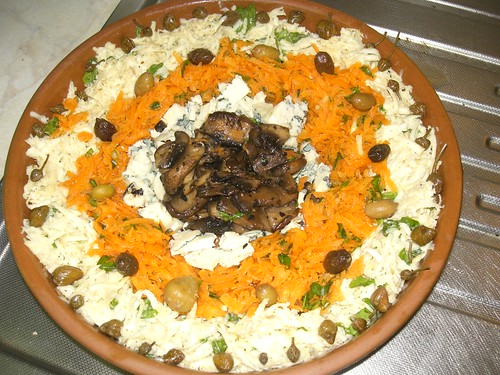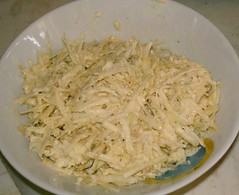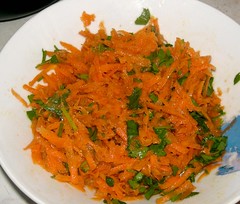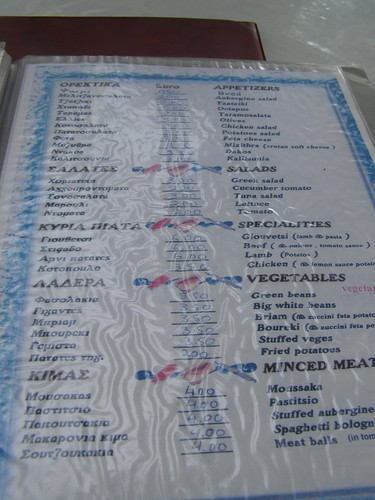There were some vegetable dishes featured in the appetiser section (entrees) at the Chartier: salade de tomate, salade frisee, salade aux endives, salade verte; as well as in a separate section labeled 'legumes': pommes anglaise, champignons provencale, haricots verts a l'anglaise, carrottes rapees, celeri remoulade. Note that each one of these mentions one vegetable and is a separate dish: it doesn't seem to feature a variety of vegetables together (as would be more common in Greece), and they all resemble something like a salad rather than a main meal (a Greek salad can easily constitute a main meal).
We didn't try any of those legumes. Mr Organically Cooked was not impressed with the mention of a single vegetable forming a whole dish. Just like I didn't fly all the way to Paris to have souvlaki, he didn't fly all the way to Paris to be served grated carrots, steamed potatoes and boiled green beans. We can (and do) prepare that kind of stuff at home. But they are always prepared a la grec, ie with olive oil and lemon poured over them, leaving an oily residue at the bottom of the dish, perfect for dunking thick slices of sourdough bread in.
Celeri remoulade; carrottes rappees
Some of those entrees constituted the cheapest items on the menu - which should signal the warning bells: if it's going to be cheap, it's going to be simple, maybe so simple that you can make them easily yourself. David Lebowitz has simple recipes for carrottes rapees and celeri remoulade on his site, both of which are considered French national dishes. His recipes allowed me to sample both these salads on the Chartier menu, prepared by my very own self. They don't use overly exotic ingredients, unless items like celery root (not grown in Crete) are considered exotic where you come from - in Crete, it's always imported from (you guessed it) Hydroponically Holland...
We make a Greek salad (known in Greece as 'horiatiki salata' - village salad) nearly every day in the summer when we have our own garden fresh tomatoes - at any other time, a Greek salad tastes like the chemicals used in a greenhouse. I always add purslane to mine, a self-rejuvenating weed that grows in our garden without being sown. The one below is how we recently enjoyed it on an outing.


Mr Organically Cooked was right: there really was no need to have had to pay for the luxury of sampling grated carrots and celery root. This stuff - no matter how tasty and filling and satisfying and easy to prepare - cannot surpass the average Greek (horiatiki) salad served at all tavernas during your summer vacation on a Greek island. You can make a meal out of that one: it contains your protein in the form of feta cheese, and you can mop up the olive oil left in the plate with some good quality sourdough bread.
This is probably one of the simplest menus you will find at a Greek island taverna (and it happens to be very cheap too); the term Λαδερά is translated here as 'Vegetables', but it actually means 'oil-based food'.
The non-vegetable meal option in the Chartier is so unlike the typical Cretan taverna menu that the average tourist will encounter, where a vegetarian will be right at home. The vegetarian option is usually entitled 'Λαδερά - Ladera', meaning 'oil-based food'. Where there is no meat, there is olive oil: boureki is a local specialty from Hania, and consists of zucchini and potato in a cheese pie, briam is an oven-cooked (ratatouille-like) vegetable medley, green string beans (haricots verts) are often paired with potatoes and summer squash in a tomato sauce, as is okra, yemista are hollowed vegetable shells stuffed with herbed rice, and giant beans are the Greek version of baked beans in tomato sauce.

French entree salads served a la grec: celeri remoulade, carrottes rappees, rocquefort, champignons (sauteed and seasoned), garnished with a few olives and capers.
If those tasty entrees at the Chartier were served together, instead of customers having to order them separately, with some rocquefort sprinkled over them, they would probably be more appreciated. They would make a great assiette vegetarienne if plated altogether. By adding one or two oeuf dur mayonnaise (another entree listed at the Chartier), I suppose I'd be having a kind of salade nicoise without the tuna.( I wonder if this is what the Chartier served as an assiette vegetarienne, in their 'legumes' section.) If they did decide to serve their entrees like this, the meal would end up looking like a kind of salade a la grec, wouldn't it, and we'd all be diving into the middle of the table with our forks to get our share, something you can't do with separate entrees, especially if some of the members of your party find the 'wandering fork' syndrome intolerable. It all depends on one's table habits, and I can tell you that the wandering fork syndrome is very much de rigeur here in Crete.
©All Rights Reserved/Organically cooked. No part of this blog may be reproduced and/or copied by any means without prior consent from Maria Verivaki.




When eating in some restaurants in the States I was surprosed that you had to purchase your vegetables separately from your main meat dish. In Canada veggies are always included on your plate, you have no choice of what kind but they are always there and may surprise you.
ReplyDeleteGreat observations again Maria! I love how you combined all the dishes and simply made it into one! It probably comes down to "food culture" in restaurants in different countries. Here in Sydney they can charge up to $10 for a side of green beans in restaurants! Really!!!
ReplyDeletewouldnt it be hilarious if you went into a greek taverna by the sea and you couldnt order vegetable dishes like a greek salata? Imagine an picture of people sitting by a seaside taverna munching on grated carrots!!!!
ReplyDeleteMaria, Chartier is not a regular restaurant, it's a surviving piece of 19th century :-) But I agree that even if French eat a lot of fresh salads, quite often it's not to accompany the meat where vegetables play often as the decoration.
ReplyDeleteI, too, prefer more veggies than meat on my plate.
ReplyDeleteLove your salade francaise, and totally share your opinion on this.
Κι εμένα μου αρεσει να έχω λαχανικά στο πιάτο και δηλώνω φανατική της σαλάτας!
ReplyDeleteHi Maria - I'm a food blogging friend of another Maria, who writes for Kali Orexi. She suggested I get in touch with you because I am coming to Crete in a few weeks for a vacation. I'll be flying to Heraklion and heading west the Hania and plan to go further to the western coast. I had made no definite plans on where to stay, what to see, where to eat and was hoping for some advice. Sorry, I couldn't find an email address on your site - would you mind sharing your advice and tips for places to visit in Crete? Thank you so much.
ReplyDeleteAdrienne from Gastroanthropology
p.s. I too find a huge absence of veggies on the menu when traveling and while I eat everything I like to have some veggies with every meal.
There are many cultures where meat/fish takes center stage in an entree and the vegetables are used as "garnish." It's always hard to get your veggies in when you are eating out. A typical "American" restaurant/steakhouse here in NY will serve "neutral" vegetable side dishes that can go with any entree, so there are always simply prepared things like Baked, Mashed or Fried Potato; Steamed Broccoli; Steamed Asparagus; Sauteed Broccoli Rabe; Sauteed Spinach; Creamed Spinach; or Mushroom Caps. The selection of vegetarian entrees are always included too, but there are usually just one or two choices of well-cooked vegetables among a slew of meat-oriented plates.
ReplyDeleteBy the way, that salad you put together in the last picture is restaurant worthy!! What a beautiful presentation of simple ingredients/flavors that I am sure tasted amazing.